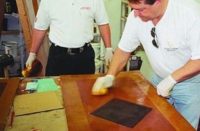
I think we can all agree we’d be happy if the decorative concrete industry were bigger. You know, if the pie were just a little bit bigger. What are we doing as an industry to positively influence the decorative market? What are you doing as a contractor, material supplier or manufacturer to help grow the pie? What are we all doing to help plant the seed for the next generation of skilled craftsmen to harvest? What are we doing to help develop the next generation of skilled craftsmen?
One thing I see a lot of manufacturers and material suppliers offering are demos, i.e., demonstrations.
I’m not seeing a lot of training. I mean, “real training,” life-sized hands-on training where real-life conditions come into play. Let’s take a moment to talk about each. What is the difference between a demo and training?
Demos are for show
A demo is just what the name implies, a demonstration. Performed by a trained professional under controlled conditions, it’s meant to entice and generate interest in a product or system. It’s meant to whet your appetite and leave you wanting more. It was never meant to be the “be all, end all” to training.
A demo is meant to have a larger-than-life, almost circus-like atmosphere. Demos sometimes get misconstrued as a form of training because the trainer may hand someone a trowel or tool and have that person get involved for a minute or two.
This doesn’t in any way, shape or form suddenly designate or make this person qualified on this new product or system. It may make he or she curious, excited and wanting to “get into” this type of work. If so, mission accomplished — the demo was a success. It doesn’t, however, mean that the participant is trained and/or qualified. A demo should be viewed as a gateway to training.

Trainings are hands-on
Training — real training — can come in different forms. Ideally, you’ll have some type of “skin” in the game. One such type of training is to pay a fee to attend a very intensive training facility for several days or weeks with life-size projects. First you learn about the specific products or systems, and then you participate on a project “hands-on” from start to finish.
You can also align yourself with a qualified contractor, someone with whom you don’t compete and is outside your geographical territory. You can offer either some form of compensation or split your profit and pickup his or her expenses on a real-life project(s) where real things happen. Where consideration must be given to sun, wind, rain and high/low temperatures. Where a bad decision or misstep can be the difference between success and failure.
One way to get training is to align yourself with a qualified contractor outside your geographical territory with whom you don’t compete. This training was conducted by Atlantic Coast Concrete at the JW Marriott in Charlotte, North Carolina.
After one job, you still won’t be fully trained, but you’ll be on your way. You may want to do several small projects as outlined above before you do one on your own.
A third option is to enlist the help of a manufacturer. Perhaps you saw a demo and liked it, and now you want to be trained. A manufacturer may have the ability to provide the type of training as indicated above. Or, the company may be able to introduce you to a qualified contractor as previously mentioned. Lastly, it can bring out its trainers to work with you and your crew on-site. They can be there to help guide and back you up.
These options can be both helpful and useful and should all be considered very carefully. Once you have participated in one of these types of trainings, you should continue to practice and hone your skills. As I’ve written before: Work at your craft and be the best version of yourself on every project.
Raise the bar on quality
Performing at your highest level on every project and improving your skills are all big steps in helping our industry grow. It will give you the confidence you need to go back to clients and ask for referrals, to offer resealing packages, to maximize your potential and get the really tough, yet rewarding, projects. It will be a differentiating factor that separates you from your competition.
If I’ve said it once, I’ve said it a thousand times: Decorative concrete done well is like a billboard on the side of the road. It’s free advertising of work done well. Or, in the digital era in which we now live, it’s like an Instagram, Facebook or LinkedIn post going viral and bringing a lot of positive attention to your work. If we raise the bar on the quality of our work, it’s only natural to think that our decorative concrete market will grow exponentially.
Tom Dombalis, president of North Carolina-based Atlantic Coast Concrete and a contractor who’s truly qualified to comment on all things concrete — decorative or otherwise — is a huge advocate for proper training. He has welcomed many contractors from other geographical regions to work side by side with him and his crew. His only request is that you come open minded and forget what you saw on YouTube. His philosophy is to improve our industry through quality work and not quantity of work. It’s to offer quality decorative concrete at a great market price.
Dombalis believes that “life is four quarters long and we should be steady to the end.” Invest in what you do, do it right and for the right reasons.
Don’t be the “quick flash in the pan and onto the next job” kind of contractor. It won’t help you and it won’t help our industry.
Learning new things can be scary. However, as you continue to perfect your craft, all the while seeking out the necessary training to grow your skillset, can ultimately prove to be highly profitable. It will be like riding your bike without the training wheels for the first time or bowling without the bumper guards. A little scary at first but oh so liberating. The higher profits you’ll be able to command aren’t so bad either.















